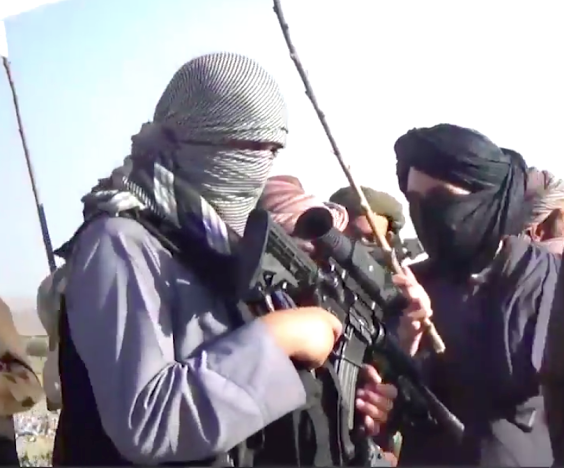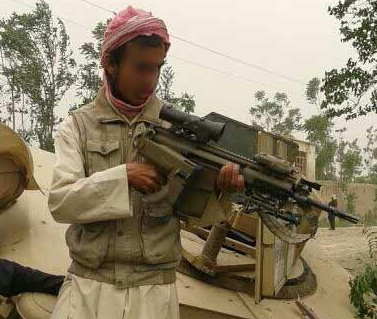The ability to execute complex operations in conditions of low light or complete darkness has been an asset unique to NATO militaries since the 1990s when fighting against local insurgencies. Often within planning sessions for OIF, OEF, or the current Resolute Support mission, it is supposed that the Taliban lack these same capabilities in their own force. Although true to a large extent due to the reduced logistical capabilities of the decentralized insurgency, there is mounting evidence to suggest that certain elements within the Taliban have not only gained infrared and thermal viewing capabilities, but are becoming proficient in their use. This essay will take a look at exactly what open source media has shown us what the Taliban have, how they are employing this equipment, but most importantly some of the techniques and procedures that are necessary for low light military operations.
Social media and the Islamic Emirates (i.e-Taliban) propaganda outlets have shown that Taliban fighters do have a multitude of the devices described and that they appear to come from different supply avenues. The majority of these supply routes appear to be from Afghan National Security Forces by way of battlefield capture or through otherwise corrupt individuals selling NVGs to third party brokers or to Taliban individuals themselves.
From a recent article on Military Times–
Corruption also plays a prominent role.
In Uruzgan for instance, ANA soldiers have sold ammunition to locals in the villages, including Taliban commanders, to bridge the gap of wage theft committed by commanding officers, the official explained.
The second source of night vision devices is through commercial supply and purchase. There is an enormous market for small arms and associated military hardware through Pakistan, some of it locally made while other items are imported, either legally or illegally. However, the evidence for optics being purchased through Russian commercial lines of supply is very difficult to ignore as
reported by Pakistan Forward in October and
echoed by Resolute Support commander General Nicholson in April of this year. Another unlikely source is from Lithuania. The title photograph for this essay shows a Pulsar Digisight 850 in use in Helmand. Pulsar is a Lithuanian optics company that produces night vision devices both thermal and infrared for hunting purposes.
One telescopic night-vision scope for the M-4 rifle, for instance, sells for $5,000 on the black market in Pakistan. Flush with cash from its domination of the
opium trade, the Taliban may simply be buying them. While many Afghan units have the M-4, few of them have telescopic sights for it.
Although Iran has covertly supported armed movements against ISAF Forces in Afghanistan in the past, there hasn’t been any open source evidence of Iranian night vision equipment in the hands of Taliban fighters, such as
we are seeing of Iranian support of Shia forces in Syria, and to some extent in Yemen.
“Utilising financial and arms support they receive from the Russians and Iranians, the Taliban are fighting security forces in Farah, Ghor, Herat and Badghis provinces,” a security source in Afghanistan’s western regions told Salaam Times on the condition of anonymity.
“The money and modern weapons they receive from Moscow have considerably boosted the Taliban’s strength in these provinces,” he said, adding that the supplies have enabled the militants to capture districts in the westernmost areas of Farah and Ghor over the past two years.
“By providing financial and arms support to terrorist groups such as the Taliban and Haqqani Network, Moscow is involved in an undeclared war with Afghanistan,” said the source.
“Security forces in [western] battlefields have repeatedly found modern Russian weapons used by the Taliban, kinds that are available only to Russian forces,” he said.
The Taliban, as much as any insurgent force facing a modern military using night vision thoroughly understands that having a night vision capability can be a force multiplier. Unlike their rivals in Syria, the so-called Islamic State which focuses much of its technological capability on drone delivered ordnance and SVBIEDs. This is probably because the threat from Iraqi and local forces with night vision capabilities has been very low due to their own lack of logistics.

To what extent does the Taliban insurgency have night vision, and is the force effective in using it successfully against ANSF forces? Both questions involve a two-fold answer. From what it appears through open sources such as propaganda videos and social media, there are elements of the Taliban that have properly functioning NVG devices. However, due to the extremely decentralized nature of the insurgency, this isn’t widespread across the entire country. One specific example from 2016 mentions a very
particular Taliban group that has taken to call itself the “Red Group” in Helmand province (
the commander has since been killed):
Sayed Murad, an Afghan special forces commander, told Reuters that the group possesses “advanced weaponry, including night vision scopes, 82mm rockets, heavy machine guns and U.S.-made assault rifles.”
A spokesman for the U.S.-led mission in Afghanistan, Brig. Gen. Charles Cleveland, told Reuters that Afghan troops might have seen Taliban forces with night vision devices but U.S. and NATO forces “not seen any evidence” of the insurgent group possessing such a capability.
This statement echoes a trend heard from from some other ANA troops that were fearful the Taliban they were facing might possess night vision capabilities that they themselves don’t have. But apart from very specific examples such as the assault group in Helmand, a
propaganda video showing an attack on an ANA patrol base in Ghorak
(
covered on LWJ here), there isn’t any evidence to suggest that the use of night vision is widespread throughout the insurgency to the point of it being used constantly and effectively. It is in use, but only within specific Taliban factions.

But it is being used effectively? And are NVGs coupled with LAM devices mounted on rifles. From what we know, the Taliban have only been marginally successful with NVGs in at least one recorded attack that shows them in use. However, the success of the attack on that particular overran patrol base in Kandahar cannot be solely attributed to what appears to only be three or four NVG devices (counted during the video). Factors such as low supplies of ammunition, possible unpreparedness of the ANA troops, their own lack of NVGs, maybe even the unit’s
unwillingness to fight due to not getting paid for months. In addition to what we know, the Taliban as a whole haven’t utilized the captured LAM units to their maximum extent. It doesn’t appear that individual fighters are realizing the potential of the LAM devices in coordination with the captured NVGs. And even if that were the case, items such as lithium CR123 batteries would have to be purchased on the open market. These types of batteries are not readily available in Central Asian markets. Especially in rural Kandahar or Helmand.
“They have their own mobile special forces unit which is equipped with lasers and night-vision gear…the Taliban were using night-vision goggles and the police who were sent were shot by laser-guided weapons against which they could not defend themselves. The police have no night-vision goggles at all.”
Another point that must be raised is the status and propaganda value of night vision, and that ability to play against the insurgency. For a perfect example, we need to look no more than at the Ghorak video where the propaganda video itself is being recorded through what initially appears to be a Russian ATN thermal optic, and then through what is possibly a PVS-14 or PVS-7. Essentially the small insurgent force’s greatest asset in this night attack is nowhere near the action at all, and is instead being used to record the assault, several hundred meters away. In the aftermath of the battle, we only see two Taliban fighters with AN/PVS-7s mounted. So the fact that one of the devices being left behind for recording purposes isn’t because the force had enough NVGs to spare leaving behind, it was because the propaganda value of recording a successful attack through captured enemy hardware was almost worth risking the entire attack itself by not using extra pairs of NVGs.
The point about status symbols must be made here as well.
Longtime British correspondent Peter Jouvenal recounted a story to the author wherein he remembers accompanying a group of Mujahideen during the Soviet occupation. The group had one SVD Dragunov precision rifle (also known as “Drahznouv” in Dari as a combination of the Russian word and the Dari word for long-دراز”) among it, and carrying it was perhaps the oldest fighter in the group, with extremely thick glasses, who could barely see. Puzzled, Peter asked why the fighter who was probably the least capable of hitting anything with the rifle was carrying it. Other fighters replied with confidence that the older fighter had the most seniority and respect within the group, so was thus given the most respected weapon. Similar status symbols are played out on today’s Afghan battlefield, the older SVD “Drahzouvs” and AKS74U “Krinkovs” (
a Pashtu term in origin) being replaced with U.S. M4A1 carbines and Mk.17 rifles, and what could very possibly be the case, NVG devices.
 Your Privacy Choices
Your Privacy Choices


